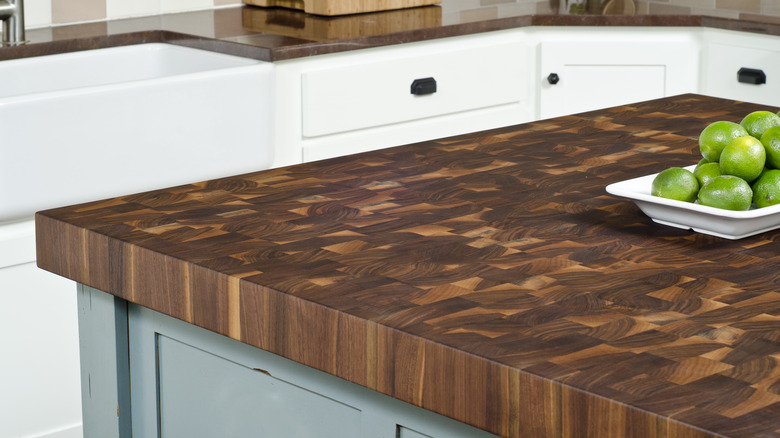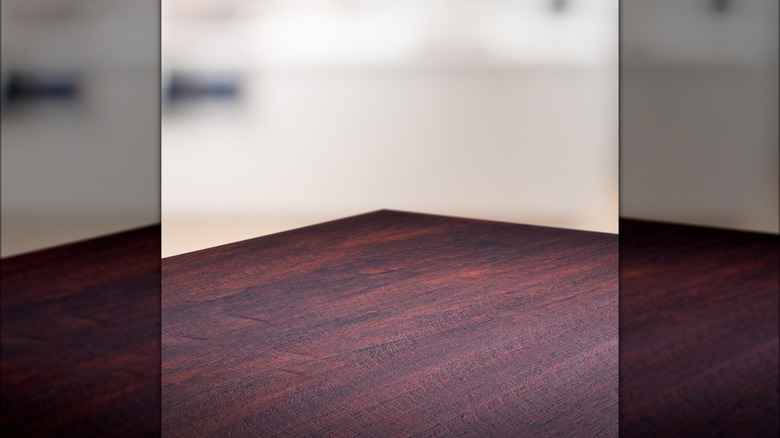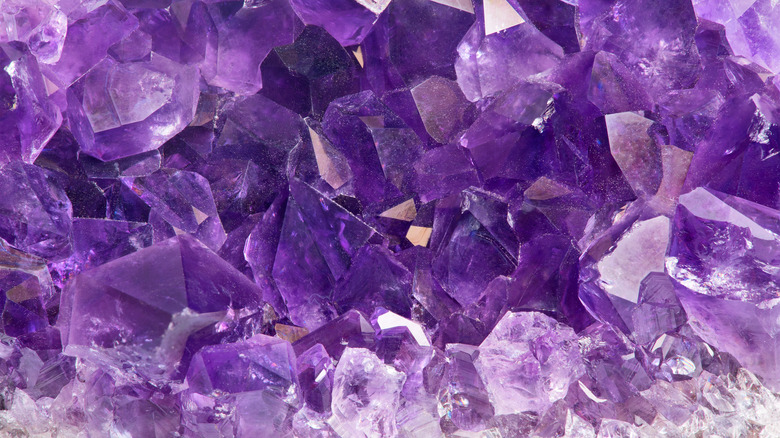What It Means When Your Kitchen Countertop Turns Purple
Given the thousands upon thousands of dollars a kitchen remodel can cost, it's no surprise people put a lot of thought and care into choosing the perfect materials for their new space, particularly large visible surfaces like countertops. Countertops actually make up approximately 10% of a total kitchen renovation cost, so that attention to detail is certainly warranted. However, with the growing popularity of natural materials as countertop surfaces, homeowners should be prepared for the possibility of their countertops gradually changing color over time. Whether solid wood butcher block or a naturally occurring stone, it's possible for its inherent makeup to fade or darken in tone or hue, possibly bringing shades of green, yellow, gray, or even purple to the forefront of the piece.
Mother Nature is a fascinating and ever-evolving entity that encompasses all the items native to the earth, whether living or inanimate. This includes all plant matter, obviously, which grows and changes with the seasons — but so too does it include rocks which morph over millennia as they are impacted by outside elements as well as those within. Natural elements by definition are not stagnant but always reacting with the world around them. Therefore, when you bring them into your home and use them as furnishings — including kitchen countertops — they may still be likely to change. In addition, simple changes in lighting may bring out shades you never realized were there before. Embrace these small imperfections as evidence of nature's infinite originality.
Wood changes color as it ages
Obviously different species of wood come in different shades and tones, and we tend to select products made from these materials for their color as much as for their hardness and durability. The addition of stains and varnishes can also deepen, change, or enhance the color of wood, but woods will also change color on their own as they age and are exposed to air and sunlight. If you have them installed as your butcher block countertops, you can expect to see these color changes reflected in your kitchen after several months or years.
One of the most common examples of a hardwood that noticeably changes color is cherry, which starts out with a pale pink blush to its boards, then deepens to a rich reddish hue. Slightly less well-known, however, is black walnut (also known as the American walnut or American black walnut), which starts out a deep, rich brown color in the heartwood but actually lightens over time -– unlike most other woods, which darken -– to show off its grayish, reddish, and yes, even purplish tones. This is not a flaw but a natural byproduct of the wood used and should be appreciated as such. Regular care with the application of mineral oil may help delay changes, but as long as we need access to air and sunlight, they won't be put off forever.
Not set in stone
Granite is one of the most popular countertop materials available, but as a natural stone, it's not a homogeneous substance. An igneous rock formed by the cooling of lava, it contains any minerals that happen to be around as well. These countertops are a mix of mica, feldspar, and quartz, at minimum. The varying compositions create the beautiful striations found in the slabs, but they can also harbor secrets (at times, granite countertops can look cloudy as well). Purple amethyst is just one example of the type of quartz that develops in the stone. The crystals grow in the veins of the rock, and their colors are influenced by the surrounding minerals, like iron. Since the crystals haven't been harvested from the slab, it's possible that they'll continue to form and bloom. Generally, if your cream or gray-lined granite countertop starts showing shades of pink or purple, it's probably a trick of the light, but there is a chance it's newly forming crystals.
Of course, if the minerals weren't there to begin with, it's possible that you've introduced them yourself from the hard water in your tap. Hard water contains an excess of minerals like calcium and magnesium but can refer to other dissolved minerals as well. These minerals in your water can interact with the ones in your stone to cause color changes, but this can be minimized by more frequent sealing. Always take proper care of your countertops, but also accept and appreciate the natural beauty they bring to your home.


